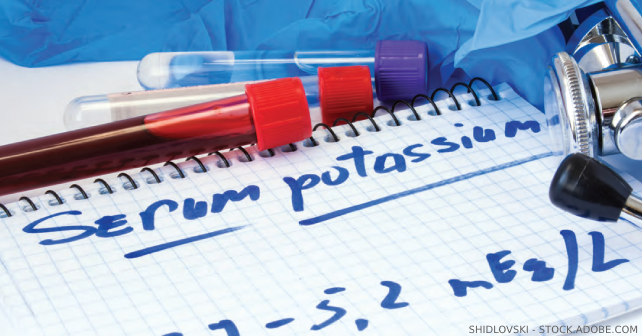
More is not always better. This is notably true when it comes to the treatment of acute hyperkalemia. Emergent treatment of acute hyperkalemia is bread-and-butter emergency medicine. Many of us have order sets that simplify care: maybe calcium, an insulin shifter or two (intravenous [IV] insulin and/or inhaled beta-agonist), coupled with perhaps a diuretic and/or a potassium binder. Intravenous insulin shifts potassium into cells, thereby lowering serum potassium within an hour of administration. Despite the routine nature of hyperkalemia treatment, adverse events from IV insulin are common and largely attributable to overtreatment.
Explore This Issue
ACEP Now: Vol 42 – No 08 – August 2023A Common Case
Hypoglycemia following insulin administration for hyperkalemia is common, occurring in approximately one in six patients (about 17 percent).1,2 Some groups are particularly at risk, especially those with renal insufficiency and those who have normal serum glucose levels. One other critical predictor of hypoglycemia is the dose of insulin administered. A meta-analysis found that reduced-dose insulin (either five units or 0.1 unit/kg) was associated with nearly half the odds of hypoglycemia when compared with 10 units of insulin (odds ratio [OR], 0.55; 95 percent CI, 0.43 to 0.69).3 This effect was magnified when restricted to severe hypoglycemia (OR, 0.41; 95% CI, 0.27 to 0.64).3 More insulin equals more hypoglycemia. The critical question is—does a reduced dose of insulin lower potassium as much as a 10-unit dose?
It appears that IV insulin doses between five and 10 units result in roughly similar reductions in serum potassium (somewhere between 0.5 and one mmol/L). A meta-analysis comparing studies using a whopping 20 units of IV insulin over 30 minutes to a 10-unit insulin bolus found no significant difference between dosing strategies; all reduced serum potassium between 0.5 and 1.14 mmol/L.4 Larger observational studies have confirmed these results and extended the findings to even lower doses of IV insulin. The majority of studies examining reduced-dose insulin for hyperkalemia have found no significant difference in potassium reduction compared with 10 units of IV insulin (mean difference, -0.02; 95 percent CI, -0.11 to 0.07). Two studies have touted a “significant” difference between a five-unit strategy and a 10-unit strategy with regard to potassium reduction.5,6 However, the difference between strategies was 0.17 to 0.27 mmol/L, which is unlikely to be clinically significant, especially as most patients returned to near-normal potassium levels. In fact, a consensus statement, Kidney Disease: Improving Global Outcomes on the emergency-department management of acute hyperkalemia, embraces the five-unit strategy.7
Monitoring Strategies
Of course, additional strategies exist to prevent and recognize hypoglycemia. Patients should have frequent blood glucose monitoring for four to six hours and patients with a serum glucose less than 140 mg/dL should receive dextrose. However, in busy emergency departments crowded with dozens of inpatient boarders, the safest and least systemically taxing dose of intravenous insulin is a dose of five units (or 0.1 unit/kg) unless there is a compelling reason for a higher dose, where a potential reduction of zero to 0.3 mmol/L would likely translate into patient benefit.

Dr. Westafer (@Lwestafer) is an attending physician and research fellow at Baystate Medical Center, clinical instructor at the University of Massachusetts Medical School in Worcester, and co-host of FOAMcast.
References
- Scott NL, et al. Hypoglycemia as a complication of intravenous insulin to treat hyperkalemia in the emergency department. Am J Emerg Med. 2019;37(2):209-213.
- Chothia MY, et al. Hypoglycaemia due to insulin therapy for the management of hyperkalaemia in hospitalised adults: A scoping review. PLoS One. 2022;17(5):e0268395.
- Moussavi K, et al. Reduced alternative insulin dosing in hyperkalemia: A meta-analysis of effects on hypoglycemia and potassium reduction. Pharmacotherapy. 2021;41(7):598-607.
- Harel Z, Kamel KS. Optimal dose and method of administration of intravenous insulin in the management of emergency hyperkalemia: A systematic review. PLoS One. 2016;11(5):e0154963.
- Finder SN, et al. 5 versus 10 units of intravenous insulin for hyperkalemia in patients with moderate renal dysfunction. J Emerg Med. 2022;62(3):298-305.
- Moussavi K, et al. Comparison of IV insulin dosing strategies for hyperkalemia in the emergency department. Crit Care Explor. 2020;2(4):e0092.
- Lindner G, et al. Acute hyperkalemia in the emergency department: a summary from a Kidney Disease: Improving Global Outcomes conference. Eur J Emerg Med. 2020;27(5):329-337.
Pages: 1 2 | Multi-Page



No Responses to “Does Reduced-Dose Insulin Reduce Potassium, Too?”